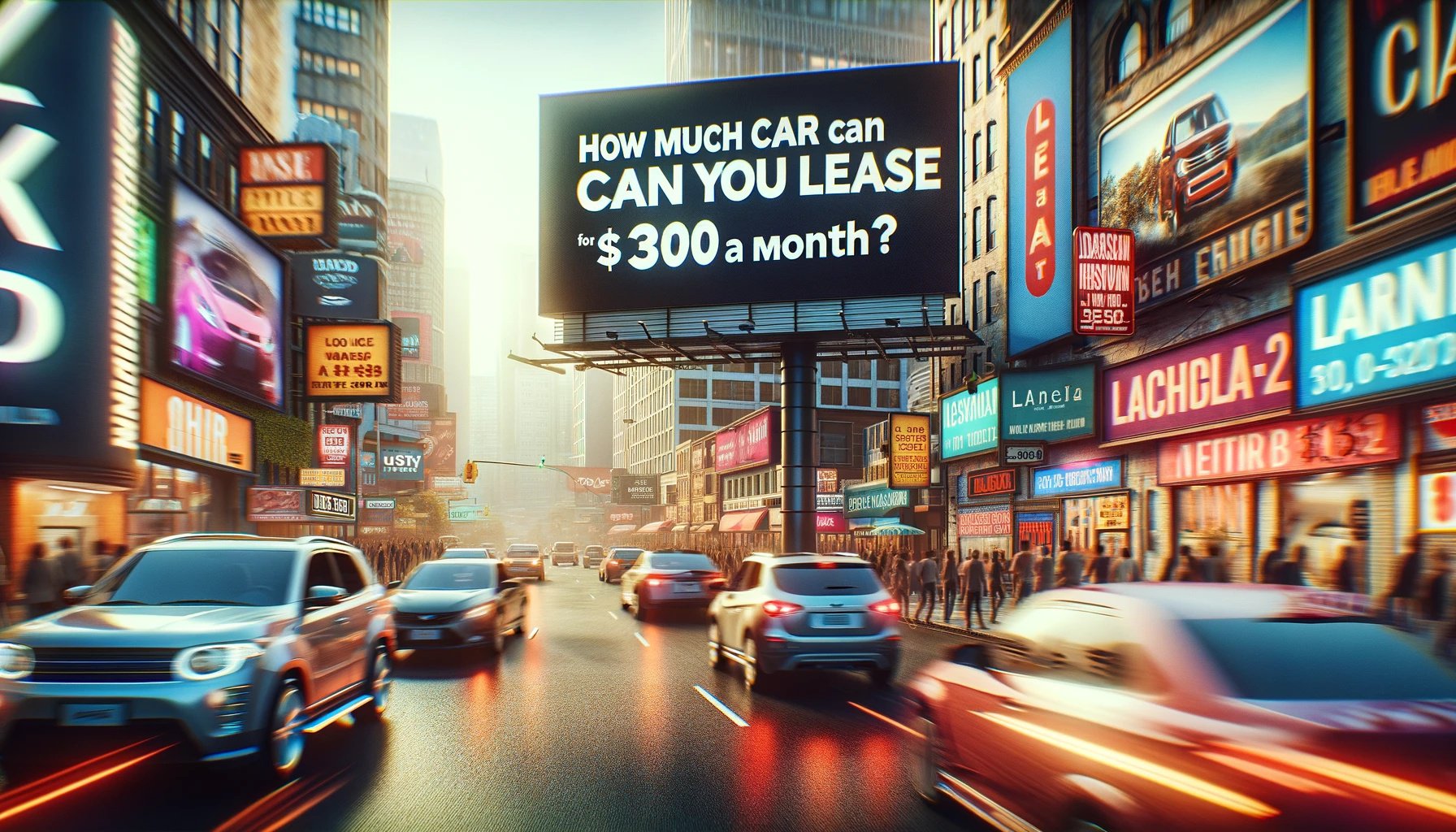In the realm of car enthusiasts and savvy budget-conscious individuals, the allure of driving a brand-new car while maintaining a monthly budget of $300 or less has become an enticing possibility. Car leasing has emerged as a cost-effective alternative to traditional car ownership, allowing individuals to experience the joy of driving a new vehicle without the burden of high upfront costs and long-term commitments. In this comprehensive guide, we will delve into the intricacies of car leasing, providing valuable insights on how to secure a dream car within a $300 monthly budget.
Understanding Car Leasing
What Is Car Leasing?
Car leasing is essentially a long-term rental agreement that enables you to enjoy driving a vehicle for a specified period, typically spanning two to three years. During this time, you adhere to predetermined lease terms that govern various aspects of your usage. It’s vital to emphasize that at the conclusion of the lease term, you do not gain ownership of the vehicle. Instead, you have several options:
- Return the Vehicle: You can choose to return the leased vehicle to the dealership and explore other leasing options or alternatives.
- Purchase the Vehicle: If you’ve grown attached to the car and wish to keep it, you can usually purchase it at a predetermined price. This is known as the “residual value” of the vehicle.
- Extend the Lease: Some lease agreements offer the option to extend the lease for a specified period, allowing you to continue driving the same car.
Pros of Car Leasing
Lower Monthly Payments
One of the most enticing aspects of car leasing is the significantly lower monthly payments it offers compared to traditional car financing. These lower payments can be a game-changer for individuals operating within a strict budget. By minimizing your monthly financial commitment, you can free up funds for other essential expenses.
Best lease deals $0 down
Opportunity for Frequent Car Updates
Car enthusiasts and individuals who enjoy experiencing the latest automotive innovations find car leasing particularly appealing. With a lease, you have the opportunity to drive a new car every few years. This means you can regularly transition from one vehicle to another, ensuring you’re constantly at the helm of a relatively new model equipped with the latest features, technology, and safety enhancements.
Warranty Coverage
Warranty coverage is a significant advantage associated with leased vehicles. Throughout the lease term, the manufacturer’s warranty typically remains in effect. This coverage extends to various aspects of the vehicle, including its mechanical components and systems. As a result, most repair and maintenance costs are often taken care of by the manufacturer or dealership, offering lessees peace of mind.
Minimal Upfront Costs
Leasing stands out for its minimal upfront costs compared to purchasing a car. While a down payment may be required, it is generally lower than what’s necessary for a traditional purchase. This reduced upfront financial burden makes leasing more accessible to individuals with limited savings or those who prefer to allocate their funds elsewhere.
Cons of Car Leasing
No Ownership Equity
One of the key drawbacks of car leasing is the absence of ownership equity. Unlike purchasing a car through traditional financing, where you eventually own the vehicle outright after completing the payment term, leasing leaves you with no tangible asset at the end of the lease period. Instead, you’ve essentially paid for the usage of the vehicle during that time, and ownership remains with the lessor or leasing company.
Mileage Restrictions and Excess Wear Charges
Lease agreements often come with mileage restrictions designed to protect the lessor’s investment and the vehicle’s residual value. Exceeding these mileage limits can result in additional charges at the end of the lease, which can significantly impact the overall cost-effectiveness of leasing. Additionally, any excessive wear and tear on the vehicle may also incur extra costs. It’s crucial for lessees to be mindful of these limitations and adhere to them to avoid unexpected expenses when returning the leased vehicle.
In summary, car leasing offers an appealing alternative to car ownership, providing lower monthly payments, the opportunity for frequent car updates, warranty coverage, and minimal upfront costs. However, it comes with the trade-offs of no ownership equity and the need to adhere to mileage restrictions and maintain the vehicle’s condition to avoid extra charges. Careful consideration of your budget, driving habits, and long-term goals is essential when deciding whether car leasing aligns with your needs and preferences
Making the Right Choice: Car Lease Comparison Guide
Factors That Influence Lease Payments
Vehicle Price and Depreciation
The cost of the vehicle and its rate of depreciation are pivotal determinants of lease payments. Here’s a closer look at how these factors impact the affordability of your leased vehicle:
- Vehicle Price: The initial price of the vehicle you intend to lease directly affects your monthly payments. Generally, a higher-priced vehicle will result in higher monthly lease payments. Therefore, it’s essential to choose a car that not only meets your preferences but also aligns with your budgetary constraints.
- Rate of Depreciation: The depreciation rate measures how much the vehicle’s value diminishes over time. Cars with slower depreciation rates hold their value better, resulting in lower monthly lease payments. Conversely, vehicles that depreciate rapidly can lead to higher lease costs. This highlights the importance of selecting a vehicle that retains its value well, as it can significantly impact the overall affordability of your lease.
Residual Value and Its Impact
Residual value is a critical component of lease calculations and plays a substantial role in determining your monthly payments. Understanding how residual value influences your lease can help you make informed decisions:
- Residual Value Definition: Residual value represents the estimated worth of the vehicle at the end of the lease term. It is expressed as a percentage of the car’s original value. For example, if a car has a residual value of 60% after a three-year lease, it means the car is expected to retain 60% of its initial value at the lease’s conclusion.
- Lower Residual Value: Cars with lower residual values typically result in higher lease payments. This is because the vehicle is projected to lose a larger portion of its value during the lease term, necessitating higher monthly payments to compensate for the depreciation.
- Higher Residual Value: Conversely, vehicles with higher residual values tend to offer lower monthly lease payments. When a car retains a greater percentage of its original value, your lease payments are based on a smaller depreciation amount, reducing your monthly financial commitment.
- Factors Affecting Residual Value: Residual value is influenced by several factors, including the make and model of the vehicle, market conditions, and manufacturer incentives. Cars from manufacturers with strong resale value histories often have higher residual values, which can translate into more budget-friendly leases.
Money Factor and Interest Rates
The money factor, similar to an interest rate in traditional financing, is another critical element in lease agreements. Understanding its impact on your lease payments is crucial:
- Money Factor Defined: The money factor, sometimes referred to as the lease factor, represents the cost of financing the lease. It is a decimal number, and to convert it into an equivalent interest rate, you can multiply it by 2,400. For instance, a money factor of 0.002 would equate to an annual interest rate of 4.8%.
- Lower Money Factor: A lower money factor translates into reduced interest costs, resulting in lower monthly lease payments. It’s advantageous to negotiate for a lower money factor when securing a lease deal, as it directly contributes to cost savings.
Lease Terms and Mileage Restrictions
The duration of your lease term and the mileage restrictions outlined in your agreement also have a direct impact on your monthly lease payments:
- Lease Term Duration: The length of your lease term significantly influences your monthly costs. Longer lease terms typically lead to lower monthly payments because the vehicle’s depreciation is spread over a more extended period. However, longer terms also mean a more extended commitment, so it’s crucial to choose a term that aligns with your preferences and future plans.
- Mileage Restrictions: Lease agreements typically specify mileage limits, such as 10,000, 12,000, or 15,000 miles per year. Exceeding these limits can result in additional charges at the end of the lease. Therefore, it’s essential to evaluate your driving habits and choose a mileage limit that suits your needs while avoiding unnecessary expenses.
In summary, several factors influence lease payments, including the vehicle’s price and depreciation rate, residual value, money factor, lease term duration, and mileage restrictions. By carefully considering these factors and making informed choices, you can secure a lease that aligns with your budget and preferences while ensuring a financially sound leasing experience.
Benefits and Considerations of a 6 Month Car Lease with No Deposit
Types of Cars You Can Lease for $300 a Month
Compact and Subcompact Cars
Cost-Effective and Efficient Commuting Solutions
For individuals adhering to a strict budget, compact and subcompact cars emerge as highly attractive options for leasing. These vehicles are renowned for their cost-effectiveness and efficiency, particularly in the realm of daily commuting. Here’s a closer look at their key attributes:
- Fuel Efficiency: Compact and subcompact cars are well-known for their exceptional fuel efficiency. Their smaller size and lightweight design often translate to fewer trips to the gas station, helping lessees save on fuel costs and reduce their environmental footprint.
- Practicality: These vehicles offer practicality and maneuverability, making them ideal for navigating crowded urban environments. Their compact dimensions allow for easy parking in tight spaces, enhancing convenience in city settings.
- Budget-Friendly: Compact and subcompact cars typically come with lower lease payments, aligning well with a monthly budget of $300 or less. This affordability ensures that lessees can enjoy the benefits of a newer vehicle without breaking the bank.
- Technology: Despite their compact size, many modern compact and subcompact cars are equipped with advanced technology and safety features, enhancing the overall driving experience and safety of occupants.
Mid-Size Sedans and Crossovers
Comfort, Space, and Negotiating Strategies
For those seeking more space, comfort, and features in their leased vehicle, mid-size sedans and crossovers present viable options. These vehicles offer a balance between spacious interiors and maneuverability. Here’s why they’re worth considering:
- Ample Room: Mid-size sedans and crossovers provide generous interior space, accommodating passengers and cargo with ease. Whether you have a family or require extra room for your lifestyle, these vehicles offer versatility.
- Comfort: With comfortable seating and advanced infotainment systems, mid-size sedans and crossovers enhance the overall driving experience. They’re designed to provide a smooth and enjoyable ride, making them suitable for long journeys.
- Negotiating Strategies: Given the versatility of mid-size sedans and crossovers, there’s room for negotiation when securing a lease deal. Savvy lessees can employ negotiation tactics to potentially secure more favorable terms, such as lower monthly payments or added incentives.
- Convenience: Mid-size vehicles often come equipped with a range of convenience features, including ample storage space, advanced safety technologies, and connectivity options. These features contribute to a more comfortable and connected driving experience.
Electric and Hybrid Vehicles
Eco-Friendly Options Within Budget
Eco-conscious consumers looking to minimize their environmental impact can explore electric and hybrid vehicles as viable leasing options. Mainstream manufacturers now offer affordable models in this category, making eco-friendly driving accessible to a broader audience:
- Environmental Responsibility: Electric and hybrid vehicles reduce greenhouse gas emissions and reliance on fossil fuels. By choosing these options, lessees actively contribute to a more sustainable and eco-friendly future.
- Affordability: Many automakers have introduced affordable electric and hybrid models that fall within the $300 per month budget range. This affordability allows individuals to embrace environmentally responsible driving without sacrificing their financial stability.
- Government Incentives: Depending on your location, government incentives and rebates may be available to further reduce the cost of leasing electric and hybrid vehicles. These incentives can make environmentally friendly driving even more cost-effective.
- Fuel Savings: Electric vehicles, in particular, offer substantial fuel savings, as electricity is often cheaper than gasoline. Lessees can benefit from reduced operating costs over the course of their lease.
In conclusion, a range of car options is available for those looking to lease for $300 a month or less. Compact and subcompact cars provide cost-effective commuting solutions, mid-size sedans and crossovers offer comfort and negotiating opportunities, and electric and hybrid vehicles present eco-conscious choices within budget. When considering your leasing preferences, factor in your lifestyle, budget, and environmental values to make the best choice for your needs.
Understanding the Surge in Car Lease Costs
Negotiating the Best Lease Deal
Research Available Offers
Informed Decision-Making
Embarking on your leasing journey requires a solid foundation of knowledge, and that begins with thorough research. Before setting foot in a dealership, invest time in understanding the current leasing landscape:
- Current Offers: Start by researching the current lease offers available from various dealerships and manufacturers. Many of these promotions can significantly impact your monthly payments and overall lease cost.
- Promotions and Incentives: Dealerships and manufacturers often roll out promotions and incentives to attract lessees. These can range from reduced money factors to cash rebates. Stay informed about these incentives to take full advantage of potential savings.
- Comparison Shopping: Compare offers and incentives from different sources. This can include dealerships in your local area, online platforms, and manufacturer websites. This step ensures you have a comprehensive view of available deals.
Understanding Manufacturer Incentives
Maximizing Savings
Manufacturers play a pivotal role in shaping the leasing landscape by offering incentives that can significantly impact your lease’s affordability:
- Reduced Money Factors: Some manufacturers offer lower money factors, equivalent to reduced interest rates, which can result in lower monthly lease payments. Understanding these factors and how they affect your lease is essential.
- Cash Rebates: Manufacturers may provide cash rebates, effectively reducing the cost of the leased vehicle. Be aware of these rebates and how they can be applied to your lease to enhance your savings.
- Lease-End Options: Manufacturers may also offer attractive lease-end options, such as lease extensions or purchase incentives. Familiarize yourself with these possibilities to make an informed decision at the end of your lease term.
Negotiating the Capitalized Cost
The Heart of the Deal
Negotiating the capitalized cost, which represents the price of the car in lease agreements, is the core of securing a budget-friendly lease:
- Research and Preparation: Before entering negotiations, arm yourself with knowledge about the fair market value of the vehicle you intend to lease. This research will help you gauge whether the dealership’s offer aligns with market standards.
- Haggling: Be prepared to haggle and negotiate the capitalized cost. Dealerships often have some flexibility in adjusting this figure to meet your budget. Polite yet assertive negotiation can yield favorable results.
- Multiple Dealerships: Don’t limit yourself to a single dealership. Explore offers from various dealerships, as each may have different pricing and willingness to negotiate. This approach widens your options and can lead to a more attractive deal.
Exploring Lease Specials
Additional Savings and Perks
Dealerships frequently roll out lease specials on select models, providing an extra layer of savings and perks:
- Savings: Lease specials can offer lower monthly payments, reduced down payments, or even waived fees. These deals can significantly enhance the affordability of your lease.
- Perks: In addition to cost savings, lease specials may include perks such as extended warranties, complimentary maintenance, or even free upgrades. Assess these benefits to determine their value and relevance to your leasing needs.
- Timing: Keep an eye on the timing of lease specials. Dealerships often align these promotions with seasonal changes or the introduction of new models. Being aware of the timing can help you maximize your savings.
In conclusion, negotiating the best lease deal requires a proactive approach. Start by conducting thorough research on available offers and manufacturer incentives. Be prepared to negotiate the capitalized cost assertively and explore lease specials to uncover additional savings and perks. With careful consideration and informed decision-making, you can secure a lease that aligns with your budget and preferences while enjoying the benefits of a cost-effective and enjoyable driving experience.
Tips for Lowering Monthly Lease Payments
Putting Down a Larger Upfront Payment
Strategic Financial Planning
One effective method to reduce your monthly lease payments is to consider making a larger upfront payment, often referred to as a down payment or cap cost reduction. Here’s how this approach can benefit you:
- Immediate Payment: By putting down a larger upfront payment, you reduce the amount that needs to be financed over the lease term. This results in a lower monthly payment, making it an attractive option for those aiming to align their lease with a specific budget.
- Lower Interest Costs: A larger upfront payment also reduces the overall interest costs associated with the lease. This can translate into significant savings over the lease duration.
- Budget Alignment: While this strategy can help lower monthly payments, it’s crucial to ensure it aligns with your financial goals and budget. Consider your available funds and whether allocating a portion as a down payment makes sense for your overall financial situation.
Exploring Different Lease Terms
Balancing Commitment and Affordability
Another avenue to explore for lowering your monthly lease payments is evaluating the length of your lease term. Lease terms can vary, typically ranging from 24 to 36 months or more. Here’s how different lease terms impact your payments:
- Longer Lease Terms: Opting for a longer lease term often results in lower monthly payments. This is because the depreciation of the vehicle is spread out over a more extended period. However, longer terms also mean a more extended commitment, so consider whether this aligns with your needs and plans.
- Shorter Lease Terms: Conversely, shorter lease terms lead to higher monthly payments. However, they offer the advantage of more flexibility and the opportunity to transition to a new vehicle sooner. Evaluate the trade-off between affordability and the desire for a frequent vehicle update.
- Balancing Act: Your choice of lease term should align with your financial goals and how often you prefer to change vehicles. Assess the trade-offs between lower monthly payments and the length of your commitment to make an informed decision.
Opting for a Less Expensive Model
Budget-Friendly Alternatives
If your desired car exceeds your budget, it’s worthwhile to consider more affordable alternatives. Making small adjustments to your preferences can have a significant impact on monthly lease payments:
- Downsizing: Explore smaller or less expensive models within the same manufacturer’s lineup. These alternatives often come with lower lease costs while still offering reliable transportation and desirable features.
- Trim Levels: Consider opting for a lower trim level of your desired vehicle. Trim levels with fewer optional features tend to have lower lease payments, allowing you to enjoy the same model at a reduced cost.
- Model Year: Explore leasing a previous model year of your desired vehicle. Dealerships may offer incentives and discounts on older models, making them more budget-friendly while still providing a quality driving experience.
Lease-End Considerations
Understanding End-of-Lease Options
Informed Decision-Making
As your lease term approaches its conclusion, it’s essential to understand your end-of-lease options:
- Return the Vehicle: You can choose to return the leased vehicle to the dealership. Ensure the car is in good condition to avoid excess wear and tear charges.
- Purchase the Vehicle: If you’ve grown attached to the car, you typically have the option to purchase it at a predetermined price, known as the residual value. This can be an attractive choice if you’ve developed a strong affinity for the vehicle.
- Extend the Lease: Some lease agreements offer the option to extend the lease for a specified period. This can provide more time to decide on your next vehicle or bridge a temporary transportation need.
Understanding these options allows you to make an informed decision that aligns with your preferences and circumstances.
Handling Excess Wear and Tear
Preparation for Lease Return
Before returning the leased vehicle, it’s crucial to ensure it is in good condition. Addressing minor damages and performing a thorough inspection can help you avoid additional charges for excess wear and tear:
- Minor Repairs: Attend to minor damages, such as scratches or dents, before returning the vehicle. Repairing these issues can prevent them from being categorized as excessive wear and tear.
- Thorough Inspection: Conduct a comprehensive inspection of the vehicle to identify any areas that may require attention. Addressing these issues in advance can save you from unexpected charges at lease end.
- Maintenance Records: Maintain records of regular maintenance and service performed on the vehicle. Having a well-documented history can demonstrate responsible vehicle care, potentially reducing the likelihood of excessive wear and tear charges.
Evaluating Mileage Overages
Proactive Planning
If you anticipate exceeding your mileage limits, it’s advisable to plan accordingly:
- Adjust Mileage Limits: Consider adjusting your mileage limits for the next lease to align with your actual driving habits. This can help you avoid unexpected charges for exceeding mileage limits.
- Calculate Costs: Calculate the potential charges for exceeding mileage limits based on your expected usage. This can provide insight into the financial implications and allow you to make informed decisions.
- Plan Ahead: Explore options for reducing your mileage, such as carpooling or using public transportation when possible. Planning ahead can help you manage your mileage and minimize additional costs.
In summary, these tips for lowering monthly lease payments and managing lease-end considerations empower you to make informed decisions throughout your leasing journey. Whether it’s through a larger upfront payment, adjusting lease terms, or exploring budget-friendly alternatives, strategic choices can enhance the affordability of your lease. Additionally, understanding your end-of-lease options and proactively addressing wear and tear and mileage considerations contribute to a smooth and cost-effective leasing experience.
List of Cars You Can Lease for $300 or Less per Month
Here’s a curated list of example cars available within the $300 monthly budget:
Make: Toyota Model: Corolla
- Monthly Payment: $200
- Due at Signing: $2,000
Make: Honda Model: Civic
- Monthly Payment: $295
- Due at Signing: $1,800
Make: Ford Model: Escape
- Monthly Payment: $290
- Due at Signing: $2,100
how much is a lease on a $45,000 car
These options represent actual car makes and models and provide a range of vehicles that fall within a $300 monthly budget, allowing you to enjoy the benefits of a newer car while managing your finances effectively. Please note that lease terms and availability may vary by location and dealership, so it’s advisable to contact local dealerships for the most up-to-date offers and availability.
Conclusion
In conclusion, leasing a dream car for $300 a month is not only possible but also a practical and cost-effective option. By understanding the nuances of car leasing, considering various factors that influence lease payments, and adeptly negotiating the best lease deal, you can fulfill your automotive desires within your budget. Remember that research and informed decision-making are your greatest allies in securing a gratifying lease deal that aligns with your financial goals. Explore the myriad deals and offers available to embark on your journey towards leasing your dream car.
Disclaimer: Prices and offers mentioned in this guide are subject to change and may vary by location and dealership. It is advisable to conduct your own research and consult with local dealerships for the most up-to-date information







